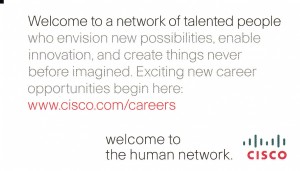simple brand tools
Recently I met with the folks in Cisco’s brand group and was delighted to find a few simple brand tools sitting in the place where a person’s business cards are usually found.
The first tool is a brand platform “cheat sheet” in the form factor of an i.d. badge. The front spells out the Cisco “Brand Aspirations”:
I like the simplicity and digest-ability of this. A succinct sentence conveys the Brand Promise and Position. Three words comprise the Brand Personality and six comprise Brand Behaviors. The use of bulls-eye clearly communicates that the Brand Promise and Position are the core of the Brand. And the background image supports the written concepts well.
The back of the “cheat sheet” complements the front of it, by indicating how the Cisco brand communicates:
I like the Is/Is Not approach, as I think understanding what a brand is not is often more instructive than learning what it is – especially for a business like Cisco which is already so expansive and continues to evolve.
Moreover, this tool is clearly intended for employees to insert into their i.d. badge holders so they have it with them at all times. This tactic is not new but I found the simplicity of the content and design to be quite compelling — and if I were a Cisco employee, I think I would actually want to look at and use the tool.
The other tool seems like a recruiting piece, but it speaks volumes about the brand as well. It’s actually a series of business card-like cards – the front conveys a welcoming message:
On the back of each card is one of several images and quotes from a Cisco staffer:
Neither the messages, images, or quotes are remarkable on their own, but as a whole, they represent the humanity, diversity, and energy of the brand – things that are important to communicate to potential employees, and anyone who works on or with Cisco. I’m not sure how these cards are intended to be used, but they make me think about Cisco differently despite not being a potential recruit. And I find them more memorable than most corporate brochure-ware.
Some companies draw a distinction between their “customer brand” and their “employer brand” — I’ve never really bought into such a delineation because I think the value you deliver and the way you do business (your brand) should be the same for customers and employees. Seeing these Cisco tools together reinforces my view — they facilitate understanding of the brand from multiple perspectives.
Finally, I like how both of these tools are available for anybody to take. The “cheat sheet” was sitting in a dispenser on the desk of one of the people I was meeting with, right next to her business cards. The recruiting cards were prominently displayed in a business card dispenser at the reception desk.
Instead of guarding their brand strategy like a piece of corporate i.p., Cisco makes it accessible and interesting. Instead of silo-ing off their recruiting efforts, they share a taste of the employment experience with everyone. Cisco, it seems, understands the value of engaging internal and external folks with their brand – after all, we’re all brand stakeholders in some way and every touchpoint is a brand touchpoint.



